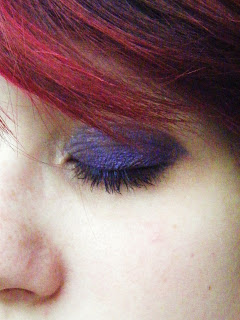YOU DO NOT HAVE TO DRINK ALCOHOL TO BE A GOTH. DRINKING WON'T MAKE YOU ANY COOLER ,AND IF YOU DRINK, DON'T DRINK AND DRIVE!
These few recommendations in advance, as I'm going to talk about the drink that is most associated with goths, beside blood of course..
I'm talking about
ABSYNTHE. It is an anise-flavored liquor or spirit that is made by steeping wormwood (wormwood has been defined as the quinine of the poor) and other aromatic herbs (hyssop, lemon balm, and angelica) in alcohol.
The drink is distinguished by its dazzling emerald blue-green clarity, due to its chlorophyll content. When mixed with water, the liquor changes to cloudy white.
Absinthe is traditionally served with water and a cube of sugar. The sugar cube was place on an absinthe spoon (a small slotted spoon), and the liquor was drizzled over the sugar into the glass of cold water until the sugar was dissolved and the desired dilution was obtained. The sugar helped take the bitter edge away from the absinthe, and when poured into water, the liquor turned a milky white. The spoons themselves were often works of art, covered with filigree flowers and stars, or shaped like sea shells.
The effect of this drink was related to the degree of dilution, the amount imbibed, and the frequency of drinking. Physical effects of nausea, disorientation, hallucination and seizure were noted by the drinkers of absinthe. Of course, these effects can be noticed by anyone who drinks too much!
According to history or legend, absinthe was originally developed by Dr. Pierre Ordinaire. He was a French doctor in self-exile due to political reasons, who was living in the Swiss town of Couvet. It was said that he discovered the plant wormwood while traveling in the Val-de-Travers. He mixed wormwood and other herbs with alcohol to create his 136 proof elixir. He used this elixir in his treatment of the sick. After many claims of miracuous healing powers, it became a cure-all. It was eventually nicknamed "
la Fee Verte," which means the
Green Fairy.
Absinthe’s progress from medicine to social poison started with the military. It is said that the demand for absinthe rose dramatically after the Algerian War (1844-1847) when the soldiers were given rations of absinthe along with their drinking water as a bacterial deterrent. The soldiers, now hooked on absinthe, began drinking it in peace time France, thus starting the first surge in absinthe popularity.
From the 1880s to the turn of the century, drinking absinthe during the cocktail hour in France became so popular that people begin calling it the I'heure verte (the green hour) for the liquor's bright green color. Generally, from 5:00 p.m. to 7:00 p.m., the cafes in Paris would be crowded with people drinking absinthe. At cafes, one could find policemen, laborers, bankers, and artists, all enjoying the elaborate absinthe ritual and all getting "loaded."
Absinthe was the "beaverage du jour" for artists, writers, and poets in Europe (including Baudelaire, Verlaine, Oscar Wilde). It was known as the drink of the Bohemians. The bohemians were self-impoverished artists, writers, musicians, free-thinkers, and counter-culture types. Manet, Toulouse-Lautrec, Degas, Picasso, de Maupassant, and especially Vincent Van Gogh are associated with absinthe. The "green fairy," as absinthe came to be called for purportedly causing hallucinations, is thought to have encouraged Van Gogh to cut off part of his left ear. They believed absinthe stimulated creativity. Absinthe was believed to raise the drinkers consciousness, insights, and emotional experience to another level. It seemed that everyone indulged themselves enthusiastically; so enthusiastically in fact that alcoholism began to be a serious problem in France.
Men and women became enthralled with the ritual of presentation as well as with the appearance, taste, and excitement of the liqueur. Absinthe was one of the few drinks considered ladylike and women freely enjoyed drinking it in the dance halls and coffee houses where it was most commonly served. Picasso painted several haunting images featuring absinthe women drinkers.

At the turn of the 20th century, much of France (and parts of the rest of Europe and the United States) were on an absinthe binge. This wide spread popularity led to an attempt at its prohibition. Backed by the French wine growers, the temperance movement targeted absinthe as responsible for alcoholism, racial degeneration, and social instability.
infos taken from: whatscookingamerica.com
In more recent times the drinking of absinthe has become closely associated with the Goth subculture and also with vampires in the popular imagination, the latter perhaps being largely due to the drink having been featured in Anne Rice's novel Interview with the Vampire, as well as (and probably even more so) to the romantic depiction of its traditional serving ritual, sensual drinking (not to mention sugar-cube sucking), and hallucinogenic after-effects in the 1992 film Bram Stoker's Dracula. It also featured prominently in the Nine Inch Nails music video The Perfect Drug, and it is presumably the preferred drink of Marilyn Manson, who produces his own brand of absinthe called Mansinthe.
infos taken from blog: courtleymanor.blogspot.com






























